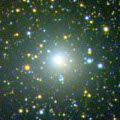
|
It reached up to 7.7 mag in summer (Aug. 13, Chris Wyatt). It is fading now, but still bright as 9.1 mag (Sept. 25, Marco Goiato). It will be getting lower gradually after this, and will be too low to observe in December. It keeps observable for a long time after 2010 in the Northern Hemisphere. But in the Northern Hemisphere, it is only observable in the low sky in 2010 spring, then it will be unobservable after that.
Date(TT) R.A. (2000) Decl. Delta r Elong. m1 Best Time(A, h)
Sept.26 19 19.57 2 20.3 2.781 3.224 107 8.6 19:15 ( 8, 57)
Oct. 3 19 15.25 -0 20.8 2.918 3.241 99 8.8 19:05 ( 16, 53)
|
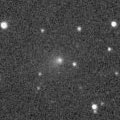
|
Now it is so bright as 8.8 mag (Sept. 24, Marco Goiato). It keeps observable for a long time until 2010 February. It will keep 9 mag until the end of 2009. But in the Northern Hemisphere, it keeps very low after this. It locates a bit higher in the Southern Hemisphere.
Date(TT) R.A. (2000) Decl. Delta r Elong. m1 Best Time(A, h)
Sept.26 15 55.06 -22 58.7 1.600 1.376 58 9.0 19:15 ( 50, 12)
Oct. 3 16 19.45 -24 15.2 1.615 1.367 57 8.8 19:05 ( 48, 12)
|
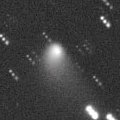
|
It brightened up to 9.8 mag on June 13 (Marco Goiato). It keeps as bright as 9-10 mag for a long time until 2010 spring. Now appearing in the morning sky. It will be observable in good condition for a long time after this in the Northern Hemisphere. It keeps visible visually for one year until 2010 autumn.
Date(TT) R.A. (2000) Decl. Delta r Elong. m1 Best Time(A, h)
Sept.26 10 39.18 6 42.3 3.133 2.255 24 9.5 4:26 (265, 5)
Oct. 3 10 52.60 7 23.7 3.084 2.252 28 9.5 4:32 (268, 10)
|
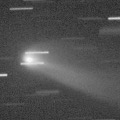
|
Now it is so bright as 9.8 mag (Sept. 23, Juan Jose Gonzalez). It will keep 10-11 mag until December. In the Northern Hemisphere, it keeps observable in good condition for a long time until 2010 spring when it becomes fainter than 18 mag.
Date(TT) R.A. (2000) Decl. Delta r Elong. m1 Best Time(A, h)
Sept.26 5 33.48 -4 22.2 0.593 1.243 99 9.8 4:26 (342, 49)
Oct. 3 5 49.69 -4 34.3 0.600 1.262 101 9.8 4:32 (348, 50)
|
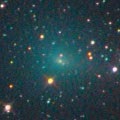
|
It brightened up to 8.8 mag in May and June (May 19, Juan Jose Gonzalez). Now it is still bright as 11.0 mag (Sept. 25, Marco Goiato). However, it will be too faint to see visually in November. It keeps observable in the evening sky for a long time until next spring when it becomes fainter than 18 mag.
Date(TT) R.A. (2000) Decl. Delta r Elong. m1 Best Time(A, h)
Sept.26 22 36.83 -15 55.6 1.043 1.981 151 11.6 22:15 ( 0, 39)
Oct. 3 22 36.55 -15 52.3 1.120 2.019 144 12.0 21:47 ( 0, 39)
|
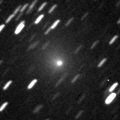
|
It brightened up to 8.5 mag in May and June (May 26, Juan Jose Gonzalez). Now it is fading, but still bright as 10.8 mag (Sept. 12, Marco Goiato). It will never be observable again in the Northern Hemisphere. In the Southern Hemisphere, it will be low temporarily in winter, but it keeps observable until when it fades out.
Date(TT) R.A. (2000) Decl. Delta r Elong. m1 Best Time(A, h)
Sept.26 13 37.12 -53 21.4 2.359 1.967 55 11.7 19:15 ( 42,-27)
Oct. 3 14 10.16 -54 27.0 2.463 2.043 54 12.0 19:05 ( 40,-25)
|
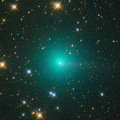
|
It brightened up to 6.7 mag in June (June 9, Marco Goiato). It faded down to 9.5 mag on Aug. 21 (Juan Jose Gonzalez), then it became unobservable. Now it is not observable. But it will appear in the morning sky again at 13 mag in November. It may be visible visually again.
Date(TT) R.A. (2000) Decl. Delta r Elong. m1 Best Time(A, h)
Sept.26 13 3.36 6 39.8 3.111 2.160 15 11.7 19:15 (100, -3)
Oct. 3 13 7.54 7 26.6 3.167 2.208 13 12.0 19:05 (103, -5)
|

|
It brightened up to 11 mag in spring and summer. Now it is not observable. It will appear in the morning sky at 15 mag in early 2010. But it locates somewhat low in the Northern Hemisphere.
Date(TT) R.A. (2000) Decl. Delta r Elong. m1 Best Time(A, h)
Sept.26 13 43.00 -11 31.8 3.096 2.229 25 13.5 19:15 ( 79, -5)
Oct. 3 13 57.26 -12 56.7 3.137 2.241 22 13.6 19:05 ( 79, -7)
|
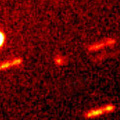
|
Already bright as 12.3 mag and visible visually (Sept. 23, Juan Jose Gonzalez). It will be getting higher after this. It will be observable bright as 9-10 mag in a good condition for a long time from winter to spring. It keeps observable until 2010 autumn when it fades down to 16 mag.
Date(TT) R.A. (2000) Decl. Delta r Elong. m1 Best Time(A, h)
Sept.26 8 36.93 17 4.7 2.530 2.133 55 13.8 4:26 (274, 36)
Oct. 3 8 51.97 16 10.4 2.428 2.094 58 13.6 4:32 (277, 39)
|

|
It must have reached up to 11 mag in summer. However, the condition of this apparition is worst. We can not observe it at all.
Date(TT) R.A. (2000) Decl. Delta r Elong. m1 Best Time(A, h)
Sept.26 12 15.39 5 34.8 2.349 1.359 6 13.9 19:15 (106,-13)
Oct. 3 12 37.06 3 11.2 2.388 1.401 7 14.5 19:05 (104,-14)
|

|
Appearing in the morning sky, and already bright in outburst. Now it is 11.7 mag (Sept. 23, Juan Jose Gonzalez).
Date(TT) R.A. (2000) Decl. Delta r Elong. m1 Best Time(A, h)
Sept.26 9 28.69 14 46.0 6.857 6.163 43 14.1 4:26 (268, 24)
Oct. 3 9 32.84 14 21.7 6.776 6.165 48 14.1 4:32 (273, 30)
|
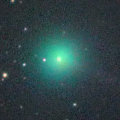
|
It has been observed bright as 8-9 mag from April to June. Now it is fading. It was still bright as 11.0 mag in July (July 12, Marco Goiato). However, no observations have been reported since August. So it may have faded out rapidly. In the Southern Hemisphere, it keeps observable in a good condition for a long time. In the Northern Hemisphere, it will never be observable again.
Date(TT) R.A. (2000) Decl. Delta r Elong. m1 Best Time(A, h)
Sept.26 10 37.37 -51 37.8 3.066 2.609 54 14.1 4:26 (317,-26)
Oct. 3 10 42.93 -52 15.7 3.156 2.688 53 14.3 4:32 (319,-22)
|
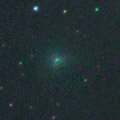
|
First return of a new bright periodic comet. It was observed as an asteroid in June, however, it unexpectely brightened up to 12.3 mag on Aug. 31 (Juan Jose Gonzalez). It is still bright as 13.6 mag and visible visually (Sept. 20, Seiichi Yoshida). In the Northern Hemisphere, it keeps observable in a good condition after this. However, it will fade out rapidly, and will be fainter than 18 mag in November.
Date(TT) R.A. (2000) Decl. Delta r Elong. m1 Best Time(A, h)
Sept.26 8 20.26 23 37.7 0.543 0.880 61 14.4 4:26 (269, 42)
Oct. 3 8 28.76 24 13.2 0.595 0.936 66 15.1 4:32 (271, 48)
|

|
Now it is not observable. It will appear in the morning sky again in 2010 February. It will brighten up to 12-13 mag in 2010 summer. But it locates somewhat low in the Northern Hemisphere.
Date(TT) R.A. (2000) Decl. Delta r Elong. m1 Best Time(A, h)
Sept.26 13 59.29 -8 16.8 3.465 2.622 27 14.5 19:15 ( 80, 0)
Oct. 3 14 10.67 -9 34.7 3.487 2.607 24 14.5 19:05 ( 80, -2)
|
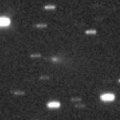
|
Now it is 15.7 mag (Aug. 31, Michael Jager). It will brighten rapidly after this. It will reach to 12 mag and become visible visually in winter. In the Northern Hemisphere, it keeps observable in good condition for a long time after this until 2010 spring when it fades out.
Date(TT) R.A. (2000) Decl. Delta r Elong. m1 Best Time(A, h)
Sept.26 5 28.86 12 40.3 1.706 2.129 100 14.9 4:26 (333, 66)
Oct. 3 5 38.07 12 14.7 1.618 2.111 104 14.5 4:32 (348, 67)
|
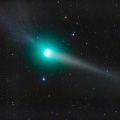
|
It passed near by the earth in late February, and it reached up to 4.9 mag (Feb. 23, Juan Jose Gonzalez). Now it is fading, but still bright as 14.8 mag (Sept. 19, Yasukazu Ikari). It is observable at 15 mag in good condition until winter.
Date(TT) R.A. (2000) Decl. Delta r Elong. m1 Best Time(A, h)
Sept.26 7 16.01 20 50.3 3.758 3.634 75 14.5 4:26 (283, 54)
Oct. 3 7 12.86 20 52.2 3.696 3.706 82 14.6 4:32 (292, 61)
|
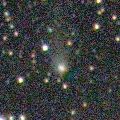
|
It brightened up to 11.5 mag in last summer (Aug. 4, Marco Goiato). Now it is 15.2 mag (Sept. 20, Yasukazu Ikari). It keeps observable in good condition for a long time in the Southern Hemisphere. It will be observable again also in the Northern Hemisphere after September. It will keep 15-16 mag until next spring.
Date(TT) R.A. (2000) Decl. Delta r Elong. m1 Best Time(A, h)
Sept.26 6 38.95 -39 57.9 4.111 4.126 83 14.7 4:26 (338, 11)
Oct. 3 6 37.04 -40 34.0 4.103 4.177 87 14.8 4:32 (345, 12)
|

|
Now it is 14.6 mag (Sept. 19, Hidetaka Sato). It passes the perihelion in September, and now it is brightest. It keeps observable in good condition in the Southern Hemisphere. In the Northern Hemisphere, it will be getting higher while fading.
Date(TT) R.A. (2000) Decl. Delta r Elong. m1 Best Time(A, h)
Sept.26 18 3.44 -45 18.1 0.751 1.230 87 14.8 19:15 ( 16, 7)
Oct. 3 18 44.09 -39 35.2 0.767 1.251 89 14.9 19:05 ( 13, 14)
|

|
It brightened up to 9.8 mag in winter (Dec. 28, Juan Jose Gonzalez). It faded down to 12.5 mag in May (May 26, Juan Jose Gonzalez), and became unobservable. It is appearing in the morning sky again. It will be observable in good condition again in winter at 15 mag. Then it may be still visible visually.
Date(TT) R.A. (2000) Decl. Delta r Elong. m1 Best Time(A, h)
Sept.26 9 57.03 11 44.5 5.328 4.551 35 14.8 4:26 (267, 16)
Oct. 3 10 2.16 10 56.0 5.313 4.605 41 14.9 4:32 (272, 22)
|
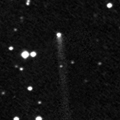
|
Now it is 15.8 mag (Sept. 4, Ken-ichi Kadota). It keeps observable in good condition at 15 mag until late autumn.
Date(TT) R.A. (2000) Decl. Delta r Elong. m1 Best Time(A, h)
Sept.26 23 49.59 29 34.1 3.029 3.937 151 14.9 23:27 ( 0, 85)
Oct. 3 23 40.41 30 9.7 3.044 3.946 150 14.9 22:50 ( 0, 85)
|
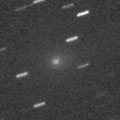
|
It is still bright as 14.5 mag (Sept. 23, Hidetaka Sato). It will be getting higher gradually while fading slowly after this.
Date(TT) R.A. (2000) Decl. Delta r Elong. m1 Best Time(A, h)
Sept.26 8 52.61 19 42.8 2.255 1.833 52 15.2 4:26 (269, 34)
Oct. 3 9 6.03 18 27.4 2.245 1.884 56 15.4 4:32 (273, 37)
|
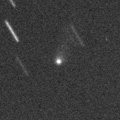
|
Now it is 14.4 mag and visible visually (Sept. 14, Alan Hale). It keeps 15 mag until winter. It keeps observable in a good condition in the Southern Hemisphere. But in the Northern Hemisphere, it will be getting lower gradually, and it is only observable until late autumn.
Date(TT) R.A. (2000) Decl. Delta r Elong. m1 Best Time(A, h)
Sept.26 23 36.49 -23 3.5 1.828 2.766 154 15.2 23:14 ( 0, 32)
Oct. 3 23 25.49 -27 4.0 1.861 2.739 144 15.2 22:35 ( 0, 28)
|
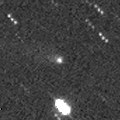
|
Now it is 15.3 mag (Aug. 22, Hidetaka Sato). It keeps 15 mag until 2010, and will be observable for a long time in good condition.
Date(TT) R.A. (2000) Decl. Delta r Elong. m1 Best Time(A, h)
Sept.26 15 31.72 34 18.5 3.166 2.784 58 15.4 19:15 (108, 40)
Oct. 3 15 30.64 32 13.4 3.236 2.785 54 15.5 19:05 (107, 36)
|
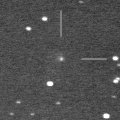
|
Now it is 16.2 mag (Aug. 13, Ken-ichi Kadota), brightening as expected. It will reach up to 12 mag in 2012, and will be observable visually at 12-13 mag for a long time from 2011 to 2013. In 2009, it is observable in good condition at 16 mag from summer to autumn. In the Northern Hemisphere, the comet will be low around its brightest seasons.
Date(TT) R.A. (2000) Decl. Delta r Elong. m1 Best Time(A, h)
Sept.26 22 0.27 2 30.7 7.590 8.452 147 15.7 21:38 ( 0, 58)
Oct. 3 21 56.25 2 2.7 7.623 8.415 140 15.7 21:07 ( 0, 57)
|
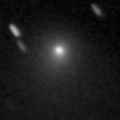
|
It reached to 10.9 mag in 2008 spring (May 11, Marco Goiato). It is fading slowly, but still bright as 15.0 mag (Aug. 20, Hidetaka Sato). Although it becomes low in winter temporarily, it keeps observable for a long time until 2010 spring when it becomes fainter than 18 mag.
Date(TT) R.A. (2000) Decl. Delta r Elong. m1 Best Time(A, h)
Sept.26 16 29.10 28 48.7 5.409 5.128 68 16.2 19:15 ( 94, 50)
Oct. 3 16 34.43 28 11.5 5.511 5.179 65 16.3 19:05 ( 95, 47)
|
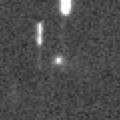
|
Now it is 16.8 mag (Sept. 20, Yasukazu Ikari). Now it is brightest, and it will be fading after October. It keeps observable until January when it becomes fainter than 18 mag. It locates somewhat low in the Northern Hemisphere. Juan Jose Gonzalez reported it unexpectedly brightened up to 14.7 mag on Sept. 23.
Date(TT) R.A. (2000) Decl. Delta r Elong. m1 Best Time(A, h)
Sept.26 1 26.20 -25 15.9 2.024 2.922 147 16.7 1:08 ( 0, 30)
Oct. 3 1 23.68 -27 8.8 2.036 2.925 146 16.7 0:38 ( 0, 28)
|
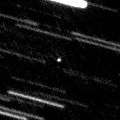
|
It passed the perihelion in June, but it was not observable, too close to the sun. Although it was predicted to be 13.5 mag, the STEREO spacecraft revealed that it brightened up to 10-11 mag, much brighter than expected. Now it is 16.4 mag (Aug. 23, C00). It keeps observable at 16-17 mag until late autumn.
Date(TT) R.A. (2000) Decl. Delta r Elong. m1 Best Time(A, h)
Sept.26 3 32.29 51 4.2 1.051 1.728 114 16.9 3:15 (180, 74)
Oct. 3 3 6.22 51 10.4 1.034 1.790 123 16.9 2:21 (180, 74)
|
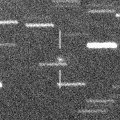
|
Now it is 17.7 mag (Sept. 5, Hidetaka Sato). It will reach up to 15.5 mag. It keeps observable in good condition all through the time until next spring when it becomes fainter than 18 mag.
Date(TT) R.A. (2000) Decl. Delta r Elong. m1 Best Time(A, h)
Sept.26 6 1.32 7 45.1 1.013 1.456 92 17.2 4:26 (323, 58)
Oct. 3 6 24.15 7 17.7 0.957 1.425 93 16.9 4:32 (328, 59)
|
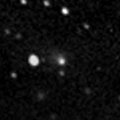
|
It brightened up to 15-16 mag in 2008 summer. Now it is 17.8 mag (Aug. 26, Katsumi Yoshimoto). It keeps observable at 17 mag in good condition for a long time until winter.
Date(TT) R.A. (2000) Decl. Delta r Elong. m1 Best Time(A, h)
Sept.26 3 56.88 33 17.4 2.500 3.102 118 16.9 3:38 ( 0, 88)
Oct. 3 3 56.34 33 55.6 2.438 3.118 124 16.9 3:10 ( 0, 89)
|
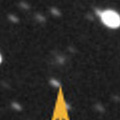
|
Now it is 17.7 mag (Sept. 10, Ken-ichi Kadota). The condition of this apparition is bad. It will reach up to 11-12 mag from spring to autumn in 2010, but it is not observable. It will be getting brighter gradually in the evening sky, but it will be too low to observe in January at 15 mag.
Date(TT) R.A. (2000) Decl. Delta r Elong. m1 Best Time(A, h)
Sept.26 20 19.63 1 2.2 2.281 2.941 122 17.3 19:58 ( 0, 56)
Oct. 3 20 18.65 0 24.6 2.320 2.897 115 17.2 19:30 ( 0, 55)
|
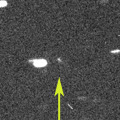
|
It brightened up to 11 mag in outburst in 2003. Now it is 17.1 mag (Sept. 20, Hidetaka Sato). It will be observable in good condition in winter. Maybe it brightens up to 14 mag.
Date(TT) R.A. (2000) Decl. Delta r Elong. m1 Best Time(A, h)
Sept.26 23 55.85 13 17.1 1.079 2.069 167 17.5 23:33 ( 0, 68)
Oct. 3 23 48.09 12 57.3 1.037 2.020 165 17.2 22:58 ( 0, 68)
|

|
Now it is 17.8 mag (Sept. 20, Yasukazu Ikari). It will brighten rapidly after this, and will be observable at 15 mag in good condition in winter and spring. It may be visible visually.
Date(TT) R.A. (2000) Decl. Delta r Elong. m1 Best Time(A, h)
Sept.26 5 13.72 14 10.0 2.108 2.545 104 17.4 4:26 (341, 68)
Oct. 3 5 19.51 14 2.2 1.993 2.510 109 17.2 4:32 (359, 69)
|

|
Peculiar asteroid moving along a cometary orbit. Now it is 17.7 mag (Sept. 12, Hidetaka Sato). It reached up to 17 mag in September and October.
Date(TT) R.A. (2000) Decl. Delta r Elong. m1 Best Time(A, h)
Sept.26 1 18.29 -7 0.1 1.097 2.072 161 17.3 1:01 ( 0, 48)
Oct. 3 0 44.82 -14 57.0 1.097 2.069 161 17.3 23:52 ( 0, 39)
|
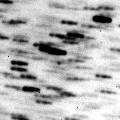
|
Now it is 16.7 mag (Aug. 14, Katsumi Yoshimoto). The condition is good in this apparition. It will approach to the earth down to 0.38 A.U., and will be observable in good condition at 16.5 mag in November. It keeps observable until that time after this. But it locates somewhat low in the Northern Hemisphere.
Date(TT) R.A. (2000) Decl. Delta r Elong. m1 Best Time(A, h)
Sept.26 17 21.92 -18 50.4 0.587 1.052 78 17.4 19:15 ( 36, 28)
Oct. 3 17 43.95 -18 38.1 0.556 1.024 76 17.3 19:05 ( 35, 28)
|
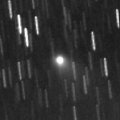
|
It reached up to 12.6 mag and became visible visually in June and July (June 25, Katsumi Yoshimoto). However, it is fading rapidly after August. It has already faded down to 17.0 mag (Sept. 1, Yasukazu Ikari). It will be fainter than 18 mag in October.
Date(TT) R.A. (2000) Decl. Delta r Elong. m1 Best Time(A, h)
Sept.26 19 39.20 1 14.6 1.300 1.918 112 17.4 19:18 ( 0, 56)
Oct. 3 19 49.46 0 52.0 1.409 1.969 108 17.7 19:05 ( 2, 56)
|
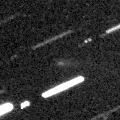
|
Comet Pigott, which has been lost over 200 years since 1783, is identified with a comet discovered in 2003 by LINEAR. Now it is 17.6 mag (Sept. 11, Catalina Sky Survey). Getting higher, but it will be fainter than 18 mag in October.
Date(TT) R.A. (2000) Decl. Delta r Elong. m1 Best Time(A, h)
Sept.26 8 22.31 46 28.4 2.314 2.166 68 17.4 4:26 (237, 48)
Oct. 3 8 40.69 47 51.8 2.279 2.201 72 17.5 4:32 (235, 51)
|

|
Now it is 17.3 mag (Aug. 23, Ken-ichi Kadota). It keeps observable at 17-18 mag for a long time until 2011.
Date(TT) R.A. (2000) Decl. Delta r Elong. m1 Best Time(A, h)
Sept.26 4 24.74 74 0.1 4.877 5.117 98 17.5 4:07 (180, 51)
Oct. 3 4 14.48 75 47.9 4.798 5.100 101 17.5 3:29 (180, 49)
|
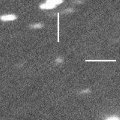
|
Now it is 18.0 mag (Sept. 21, Mt. Lemmon Survey). It keeps observable at 17 mag for a long time from 2010 to 2012.
Date(TT) R.A. (2000) Decl. Delta r Elong. m1 Best Time(A, h)
Sept.26 3 33.21 20 36.3 8.201 8.840 126 17.5 3:15 ( 0, 76)
Oct. 3 3 29.26 20 30.6 8.090 8.823 134 17.5 2:43 ( 0, 76)
|
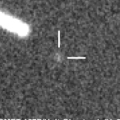
|
It became much brighter than expected. It was originally predicted to be 19 mag, but now it is 17.2 mag (Sept. 13, Yasukazu Ikari). It will be observable in good condition at 17-18 mag until November.
Date(TT) R.A. (2000) Decl. Delta r Elong. m1 Best Time(A, h)
Sept.26 1 9.05 6 10.0 1.220 2.203 164 17.6 0:51 ( 0, 61)
Oct. 3 1 2.69 6 42.3 1.203 2.199 172 17.5 0:17 ( 0, 62)
|

|
Now it is 17.7 mag (Aug. 31, D. Cardenosa and R. Lozano). This comet tends to brighten after the perihelion passage. It will reach up to 16-17 mag in 2010 and 2011.
Date(TT) R.A. (2000) Decl. Delta r Elong. m1 Best Time(A, h)
Sept.26 4 56.89 25 22.2 2.825 3.264 107 17.7 4:26 (344, 80)
Oct. 3 4 59.70 25 28.6 2.727 3.256 113 17.6 4:13 ( 0, 80)
|

|
Peculiar asteroid moving along a cometary orbit. Now it is 18.1 mag (Sept. 12, Hidetaka Sato). It reached up to 18 mag in September and October.
Date(TT) R.A. (2000) Decl. Delta r Elong. m1 Best Time(A, h)
Sept.26 0 58.52 0 38.9 2.620 3.607 168 17.9 0:41 ( 0, 56)
Oct. 3 0 42.19 -0 48.9 2.601 3.599 175 17.7 23:51 ( 0, 54)
|
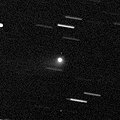
|
It reached up to 14 mag in 2008 autumn. It is still bright as 16.8 mag (Sept. 17, Catalina Sky Survey). It keeps observable around 17 mag in a good condition for a while.
Date(TT) R.A. (2000) Decl. Delta r Elong. m1 Best Time(A, h)
Sept.26 21 45.25 13 35.5 4.186 5.014 141 17.8 21:23 ( 0, 69)
Oct. 3 21 37.81 12 29.0 4.299 5.058 135 18.0 20:48 ( 0, 67)
|
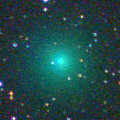
|
It was bright as 8-9 mag in April and May. Although it had been unobservable for a while, now it is appearing in the morning sky. It should be bright as 12 mag still now, however, it has faded down to 16.7 mag actually and become much fainter than expected (Sept. 9, Ken-ichi Kadota). In the Northern Hemisphere, it keeps low after this. In the Southern Hemisphere, it keeps observable in good condition for a long time.
Date(TT) R.A. (2000) Decl. Delta r Elong. m1 Best Time(A, h)
Sept.26 8 7.67 -11 23.9 2.688 2.373 61 18.0 4:26 (304, 23)
Oct. 3 8 9.87 -14 36.2 2.672 2.448 66 18.4 4:32 (313, 26)
|
|
![]()
 29P/Schwassmann-Wachmann 1
29P/Schwassmann-Wachmann 1 C/2009 G1 ( STEREO )
C/2009 G1 ( STEREO ) 222P/2009 MB9 ( LINEAR )
222P/2009 MB9 ( LINEAR ) 65P/Gunn
65P/Gunn 118P/Shoemaker-Levy 4
118P/Shoemaker-Levy 4 C/2007 N3 ( Lulin )
C/2007 N3 ( Lulin ) C/2007 G1 ( LINEAR )
C/2007 G1 ( LINEAR ) (3552) Don Quixote
(3552) Don Quixote C/2006 OF2 ( Broughton )
C/2006 OF2 ( Broughton ) C/2008 P1 ( Garradd )
C/2008 P1 ( Garradd ) 64P/Swift-Gehrels
64P/Swift-Gehrels C/2009 O4 ( Hill )
C/2009 O4 ( Hill ) C/2008 N1 ( Holmes )
C/2008 N1 ( Holmes ) C/2006 S3 ( LONEOS )
C/2006 S3 ( LONEOS ) C/2006 Q1 ( McNaught )
C/2006 Q1 ( McNaught ) P/2009 Q5 ( McNaught )
P/2009 Q5 ( McNaught ) (3200) Phaethon
(3200) Phaethon P/2009 Q4 ( Boattini )
P/2009 Q4 ( Boattini ) 47P/Ashbrook-Jackson
47P/Ashbrook-Jackson 43P/Wolf-Harrington
43P/Wolf-Harrington 157P/Tritton
157P/Tritton 30P/Reinmuth 1
30P/Reinmuth 1 2009 QY6
2009 QY6 107P/(4015) Wilson-Harrington
107P/(4015) Wilson-Harrington P/2009 L2 ( Yang-Gao )
P/2009 L2 ( Yang-Gao ) 226P/2009 R2 ( Pigott-LINEAR-Kowalski )
226P/2009 R2 ( Pigott-LINEAR-Kowalski ) C/2007 VO53 ( Spacewatch )
C/2007 VO53 ( Spacewatch ) C/2008 S3 ( Boattini )
C/2008 S3 ( Boattini ) 127P/Holt-Olmstead
127P/Holt-Olmstead 203P/2008 R4 ( Korlevic )
203P/2008 R4 ( Korlevic ) 2008 SO218
2008 SO218 C/2007 U1 ( LINEAR )
C/2007 U1 ( LINEAR ) C/2009 F6 ( Yi-SWAN )
C/2009 F6 ( Yi-SWAN )![]()



































